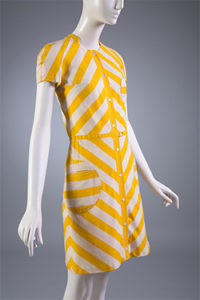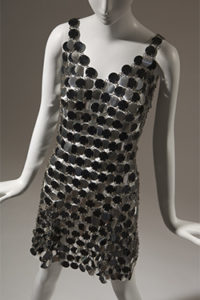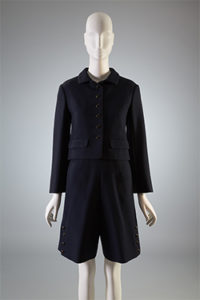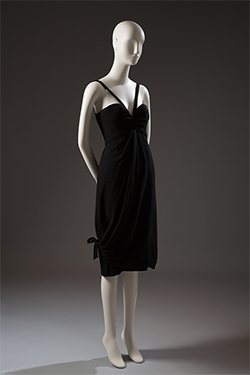April 15 is the last day to see the standout show “Paris Refashioned, 1957-1968” curated by Colleen Hill at the Museum at FIT (closed Sundays and Mondays; admission is free). It’s a fascinating look at how the birth of ready-to-wear in France changed the fashion industry in ways that are still being felt today. As the market for laborious, expensive tailor-made clothing shrank, the French fashion industry found new life with the mass production methods of ready-to-wear, and responded to the changing desires of a young, liberated generation of women.
Yves Saint Laurent Makes his Mark
This look at French fashion starts in 1957, the year that 21-year-old Yves Saint Laurent became the creative director at Dior after Christian Dior‘s sudden death from a heart attack. Having just finished translating a biography of Saint Laurent by Laurence Benaïm (forthcoming from Rizzoli), I was excited to see examples from his work at Dior, including the classic Trapeze dress. Saint Laurent launched his ready-to-wear line Rive Gauche in 1966, bringing the prestige of designer clothing into the reach of a larger and younger group of women. His couture designs could also be cutting-edge, as in the black wool crepe cocktail dress he made at Christian Dior in 1959 (shown above).
Styles That Stand the Test of Time
The main room of the exhibition has mannequins arranged in various configurations in the center of the room, and walking around them is like stumbling into a party or streetscape of vivid 1960s French fashion trends that’s been frozen in time. Many of these styles I’d feel comfortable slipping on today, such as Emmanuelle Khanh‘s button-down short-sleeved cotton dress with vivid white and yellow stripes from 1966.

The “Chain Mail” evening dress by Paco Rabanne, also from 1966, is made of sparkly black and silver plastic discs (an early use of plastic in fashion — though they look metallic) that are linked together with little metal hooks. It looks fabulous, though it could be tricky to figure out what to wear underneath for some unobtrusive coverage — maybe a flesh-colored bodysuit?

Not everything looks current. There are lots of pantsuits, which in the 1960s were all the rage. The pantsuits with shorts or culottes were an especially unfortunate French fashion trend, in my opinion, as in this example by Gérard Pipart for Nina Ricci.

The Influence of 1960s French Fashion Today
Seeing all these designs in one room, I was struck by how many different style experiments were happening at once during that era, and how they took advantage of new developments in fabrics. Many cocktail dresses from the 50s, including the Yves Saint Laurent example at the top of this post, were made of wool or wool crepe, which seems constricting and old-fashioned today. The world of ready-to-wear embraced cheaper fabrics such as cotton, and stretchier fabrics such as cotton jersey or wool jersey. Practical synthetics became more common, and vinyl and plastic made an appearance as decorations or trim.
As the wild strains of rock music took over the airwaves and French New Wave directors experimented with cinematic storytelling, fashion designers made clothes in which women could live out cultural changes in their daily lives. By 1972, the fashion writer Hebe Dorsey concluded, “Fashion liberation has taken over from fashion determinism. Each woman is free to choose for herself, to interpret the mode according to her own style, taste, and figure, to participate in creation without being reined in by absolutes.” This is something we take for granted today, but it’s actually a historical development that is fun and thrilling to revisit.

